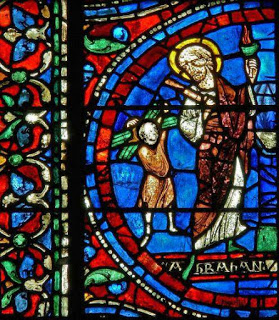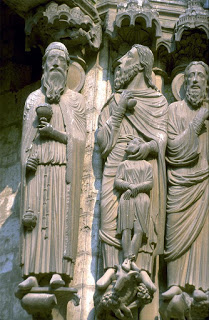Medieval History
There is a place where laughter and fire meet, and that is in the story of the Binding of Isaac. (Though one does wonder about the presence of laughter in the union of firestones - Marian Bleeke wonders about their gender here.) "Isaac" isn't only a name, it's a lovely phrase in Hebrew: he laughs, he who laughs, he will laugh. The announcement of his birth caused the first controversial laughter: Abraham laughed to think of parents as old as he and Sarah having a child; and Sarah laughed (and here you must decide, for she and God and Abraham do a little back and forth on this) to think that a woman as old as she could become pregnant from a man as old as Abraham. But she did, and Isaac was born, and at a certain age (he's a child in the images, but the text indicates a young man) he became a part of one of the must haunting stories of the Bible (all those commentaries, all those images). In this beautiful window from Chartres, the story of the Binding of Isaac is split into two panels placed on either side of the Descent from the Cross (the entire window is typological, creating a kind of visual echo chamber between Hebrew Bible/Old Testament events and New Testament events). I say "beautiful" because representing this particular scene, in which Isaac carries the wood that will be lit for his sacrificial pyre, is relatively rare. There's a human touch here in the small child struggling with the (of course) cruciform wood, while his father looks back - to hurry him along? to comfort him? to offer to help? The dangers, the trouble, the agony of reading the Binding of Isaac story is reading it literally. You just can't. What father would do that to his son? And so, let the interpretations begin, about tests and loyalty, about prefigurations and mercy. Thank goodness. This panel is also exceptional to me in how it isolates all of the key elements visually: Isaac, the wood, Abraham, the fire. Stained glass, whose existence relies of fiery processes, is in a unique position to represent fire. There's a thickness about that torch flame, a depth of color, that gives the fire character: controlled and sure now, before it's to be used for unimaginable purposes. The fire that Abraham will light believing he is about to sacrifice his son because Gold told him to, is only the second one lit in the Bible. The first occurs in the firepot that burns between the pieces of sacrificed animals as God makes his first covenant with Abraham, the one about land. The second fire is Isaac's. And the scene above reveals Genesis 22:6 ("Abraham took the wood for the burnt offering and placed it on his son Isaac, and he himself carried the fire and the knife. As the two of them went on together") with an unnerving simplicity.
And so laughter and fire have been conjoined for a long, long time. Their suddenness and their power and their salvific ability have been sought since the earliest stories of the Bible. The story offers moments that have nothing to do with its ending: volatile moments that turn the story from beautiful to sinister, moments that themselves oscillate between blessed innocence and horrific knowledge. This sculptural group from Chartres is one. I have always been completely captivated by the way Abraham runs his fingers along his son's neck, how divided his attentions are between his dear boy whom he steadies in that gentle touch and his inscrutable god to whom he addresses with his gaze. I have always wondered about Isaac's stance: his hands are not actually bound by anything, they're just resting that way, his legs in slight contrapposto as he relaxes against his father's body. I always imagine him pressing his left ear into his father's palm. His feet are bound, resting lightly on the ram's head - the animal figure upon whom Isaac's deliverance depends. Melchisedek stands to their left, ready with ritual offerings, ready to make all of this symbolic and take it out of the realm of the real. Away from the intensity of a boy who is laughter and a sacrificial fire.
- The Medici Code: Tales Of Medieval Daring Found In Hebrew Manuscript
It is a story which out-Dan-Browns Dan Brown, a tale of Italian mediaeval courts, spies, intrigue, and, at its heart, an extraordinary Jewish scholar, Abraham Ben Mordecai Farissol. Farissol, who lived between 1469 and 1528, was the author of a remarkable...
- Medieval Glass At York Minster Saved From Fire
York Minster's 600-year-old stained glass window has been saved from fire. Fire crews and York minster staff spent the night moving more than 300 panels of stained glass as fire broke out at the minster stonemasons' yard. About 30 firefighters...
- Generational Difference And Medieval Masculinity (2 Sessions)
The following sessions will be of considerable interest to several list members, I think. I send it along to you with the usual pleas for forgiveness for cross-posting. Please feel free to forward to other interested parties! Generational Difference...
- Two From Two - The Coming Of The King - M.c. Scott
  The Coming of the King by M.C. ScottThis is Book Two in the fantastic historical fiction series Rome by M.C. Scott (aka Manda Scott). The first book in the series, Rome: The Emperor's Spy, went down as the...
- It's Amazing What You Find Under The Floor.
According to John Throsby in his new addition of Thoroton's The Antiquities of Nottinghamshire, when the floor of the chancel at Mattersey church in Nottinghamshire was replaced in the 1790s they discovered two pieces of 'very ancient'...
Medieval History
Laughter and Fire
 |
| Abraham and Isaac, Chartres Cathedral, 13th c. |
 |
| Abraham and Isaac, N. transept, Chartres |
- The Medici Code: Tales Of Medieval Daring Found In Hebrew Manuscript
It is a story which out-Dan-Browns Dan Brown, a tale of Italian mediaeval courts, spies, intrigue, and, at its heart, an extraordinary Jewish scholar, Abraham Ben Mordecai Farissol. Farissol, who lived between 1469 and 1528, was the author of a remarkable...
- Medieval Glass At York Minster Saved From Fire
York Minster's 600-year-old stained glass window has been saved from fire. Fire crews and York minster staff spent the night moving more than 300 panels of stained glass as fire broke out at the minster stonemasons' yard. About 30 firefighters...
- Generational Difference And Medieval Masculinity (2 Sessions)
The following sessions will be of considerable interest to several list members, I think. I send it along to you with the usual pleas for forgiveness for cross-posting. Please feel free to forward to other interested parties! Generational Difference...
- Two From Two - The Coming Of The King - M.c. Scott
  The Coming of the King by M.C. ScottThis is Book Two in the fantastic historical fiction series Rome by M.C. Scott (aka Manda Scott). The first book in the series, Rome: The Emperor's Spy, went down as the...
- It's Amazing What You Find Under The Floor.
According to John Throsby in his new addition of Thoroton's The Antiquities of Nottinghamshire, when the floor of the chancel at Mattersey church in Nottinghamshire was replaced in the 1790s they discovered two pieces of 'very ancient'...
